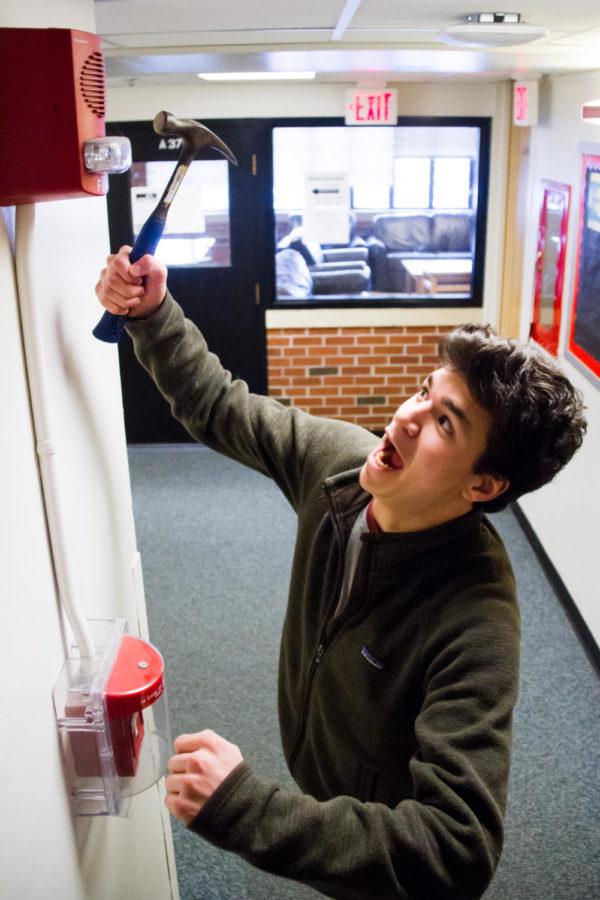- News
- News / Politics And Administration
- News / Politics And Administration / Campus
- News / Student Life
ISU fixes deferred maintenance for fire safety
Fire Alarm Picture
March 24, 2016
The Board of Regents released its Facilities Governance Report, in which fire safety and deferred maintenance for all three regent institutions were discussed.
The report outlines deferred maintenance as “the repair or replacement of all, or a part of an existing capital asset that was not repaired or replaced at the appropriate time because of a lack of funds.” The document clarifies between deferred maintenance and building renewal, the latter being the replacement of systems when it should be replaced.
Universities across the nation are finding problems with deferred maintenance, as funds may be hard to allocate and most university buildings were built or expanded during the 1960s and 1970s during the higher education boom, the report states.
Iowa State has looked to correct any deferred maintenance problems in the last few years. Curtiss Hall, Food Science, Forker and Olsen were the four examples outlined in the report from the regents that have seen major corrections and renovations to fire safety systems.
“When you have almost 14 million square feet of space on campus you’re going to have things that break, you’re going to have things that … people that are in there aren’t aware of all of the code requirements,” said Troy Carey, fire safety specialist for the Environmental Health and Safety Department. “For a university that has that many square feet and buildings you’re going to have some [problems.]”
Carey said there should be no concern for any building on campus being in “imminent danger of burning down,” but that “you can’t go into any building and walk out like … there’s nothing,” which is why the university has been updating buildings to comply with fire safety initiatives.
The current cost of the deferred maintenance project has topped off about $6 million, which is funded by facilities, Carey said. The cost addresses adding sprinkler systems to nine buildings or adding self-closing doors while also adding emergency lighting and exit signs to more clearly designate evacuation routes. Carey said Iowa State chose to update the buildings with sprinkler systems, which is why the cost is so high.
“We put down everything that needs to be fixed, how it’s going to be fixed and what we think it’s going to cost and that’s where we get this $6 million figure,” Carey said. “But this number is kind of misleading because that includes the cost of adding sprinkler systems to nine buildings.”
Carey said Iowa State chose to update the buildings with sprinklers because they are a safer, albeit more expensive option.
“Sprinklers are the way to go,” he said. “They are more protective for the people and the property itself.”
Instrumental changes have been made to the four buildings the report used as an example. Both Curtiss and Forker passed their inspections with no violations, while Food Science and Olsen had only a few violations — adding smoke detectors and sprinkler coverage to minor areas.
Before the updates were made, the buildings still had fire safety measures. Carey said proper exiting has been updated and maintained from the 1970s and 1980s. Any building that does not have a sprinkler system is sure to have self-closing doors, and new buildings are automatically installed with sprinkler systems. Buildings undergoing any renovations are also installed with sprinkler systems.
“Our buildings either have sprinkler systems or they have fire alarm systems or they have both,” Carey said. “So there is some early notification when there is a potential fire so we can get people out of the building quickly.”
The detectors set off an alarm as soon as they sense smoke. They’re also set up to automatically notify the ISU Police Department. As soon as ISU Police gets a notification of a fire from a building, the force contacts the fire department, which has about a four-minute response time.
Molli Koehler, junior in elementary education, said the code not being up to par previously makes her a “little uneasy,” but she isn’t too worried.
“I mean the fact they have been fixing it is good,” Koehler said. “It doesn’t really dictate what I would do or where I spend my time, I don’t think.”
Carey said students shouldn’t have a safety concern when it comes to the fire codes being maintained on or around campus.
“The buildings that we have, yes, we have deficiencies in them, but the buildings are very fire safe,” he said. “I mean, we don’t have buildings that have substandard exiting. It’s easy to get out of the buildings, and if we don’t have sprinkler systems, we have fire alarm systems, which give early notification,” he said. “In general, our buildings at Iowa State are very fire safe. These are relatively minor deficiencies that have to be corrected.”

















